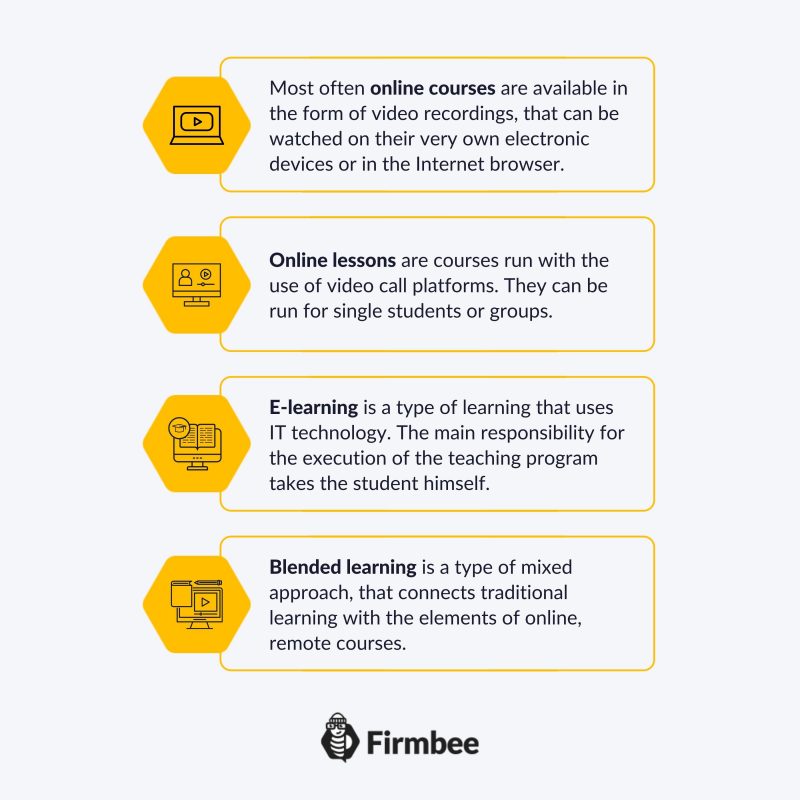What are online courses? Internet courses have become popular in recent times due to technological advancement and the spread of remote work. It is a comfortable form that allows users to gain knowledge at any time. Let us explain the differences between different types of internet courses. Besides internet courses, other forms allow access to knowledge and learning with the use of information technologies.
What are online courses? – table of contents:
- What are online courses?
- What are online lessons?
- What is e-learning?
- What is blended learning?
- Advantages and disadvantages of online courses
- Synchronous and asynchronous learning
What are online courses?
Online courses are the modern approach to the creation and dissemination of valuable educational content. Most often they are available in the form of video recordings, that can be watched on their very own electronic devices or in the Internet browser.
Some creators attach downloadable files, for example in pdf format, that can be printed out by the student. Such work cards and exercise sheets allow for systematizing of the knowledge gained during the online course. Worksheets that can be filled online are in broad use as well.
The main feature of Internet courses is their well-thought structures, where the course is divided into separate lessons and modules. The student can check the schedule of the course and follow his progress.

What are online lessons?
Online lessons are courses run with the use of video call platforms. Till today, the most popular platform used for online lessons was Skype. The need for better teaching platforms emerged during the lockdown. Zoom, Microsoft Teams, and Discord have reached higher popularity.
Online lessons can be run for single students or groups. They are similar in many aspects to classes at school, and the main difference is the delivery that uses electronic devices and Internet connection. This solution has some disadvantages, especially for individuals with a weaker Internet connection – they may have problems with attendance on online courses.
What is e-learning?
E-learning is a type of learning that uses IT technology. It may be a form of supplement to the traditional forms of teaching and learning. The main responsibility for the execution of the teaching program takes the student himself, not the course provider. The user gets access to the platform and learning content, where he single-handedly covers the material provided. After the completion of the course, the user may take the test.
Another popular form of leering is currently m-learning, where the course is specially designed for smartphone users. By getting access to the platform we may log in through the internet browser or dedicated application. Usually, m-learning platforms restrict their offer in time.
The most known example of an e-learning platform is Duolingo. With this tool, the user may learn the English language. After the purchase one gets access to all needed materials and other useful functionalities.
What is blended learning?
Blended learning is a type of mixed approach, that connects traditional learning with the elements of online, remote courses. Stationary lessons are conducted by the teacher, but the rest of the learning is done with the use of IT technology and requires some dose of self-discipline.
The frequency of meetings is set individually accordingly to the type of course or needs of the participants, and the availability of the teachers. Flexibility has a positive impact on the efficiency of this method of learning.
Advantages and disadvantages of online courses
The main advantage of online courses is their availability. The user may start a course at any time and continue the learning as long as he needs. Time and localization are not problems anymore. The market of online courses is broad enough that anybody can find something for himself. Frequently those solutions are cheaper than traditional stationary courses. The next advantage is the possibility to go back to the content and redo the lesson again.
Internet courses have some disadvantages as well. First and foremost all individuals with low levels of self-discipline may have problems with organization. The contact with the teacher is restricted, although some online course creators assure us that, after the purchase of the course, they are available to consult any issue related to the content of the course – we may ask them questions. Although it is never clear if and when will we get the answers.
Another disadvantage is the limited range of material available in online courses. Not all of the lessons may interest us and some may be better delivered. Unfortunately, the lack of direct contact with the teacher makes it impossible to inform him about it, we cannot omit topics we know about already or expand on subjects that seem more interesting at a time.

Synchronous and asynchronous learning
Synchronous learning, as the name point out, is the form of learning, where a group of people is studying at the same time. All the participants are present at the same place and at the same time – it may be the classroom at school or the same online platform on the Internet.
The main advantage of such a learning process is the interaction with the other users and the instructor in real-time. Thanks to this all the participants may share their observations and doubts. Such type of training has a strictly specified schedule as well.
Asynchronous learning is the opposite of synchronous learning. There is no interaction between participants in real-time. The whole system is based on the designed previously material. This approach has many advantages because the participant is not dependent on the predetermined schedule. A student may carry out the program at their speed, in their own time.
Summary
The market for online teaching is diversified. People may choose the best model for themselves and their abilities. It is worth knowing what types of internet courses are available on the market as well as what other solutions are in use. With such knowledge, while creating our courses, we may assess who could be interested in our online learning product.
If you like our content, join our busy bees community on Facebook, Twitter, LinkedIn, Instagram, YouTube, Pinterest.
Author: Martin Sparks
E-commerce enthusiasts which constantly digs around the internet in order to make sure he hasn’t missed any important information on the topic of starting and scaling profitable online stores.
Create & sell digital products:
- What are digital products?
- Why you should create your own digital products?
- 8 digital product ideas
- Best sales models to sell digital products
- How to use subscription model to sell products?
- What is an e-book?
- What to write an ebook about
- How to create an ebook?
- 8 examples of best ebook creation software
- How to create an ebook in Canva?
- 11 common ebook writing mistakes to avoid
- 5 ebook publishing mistakes to avoid
- 10 best platforms for selling ebooks
- 7 reasons to write an ebook for your business
- What are online courses?
- Types of online courses you can create and sell
- 9 features of a good internet course
- 7 things you need to do before creating an online course
- How to create your own online course?
- The best online course creation tools
- How to record online video courses?
- How to sell online courses?
- Best online course marketplaces
- Best online course platforms
- Online templates: 7 ideas for online templates that sell
- How to sell Canva templates: 6 steps to the final product
- Best online marketplaces to sell templates online
- What are stock images?
- How to make a stock photo? 10 great tips for awesome images
- How to sell stock photos?
- What is stock music?
- 6 stock music libraries to make money
- How to sell stock videos online?
- What is software? Types and methods of distribution
- How to sell your software?
- How to create your own mobile app?
- 5 programs to build apps without coding
- How to sell mobile apps?
- 6 models of app monetization
- How to sell digital products on Etsy?
- How to sell digital products on Shopify?
- What do you need to know about selling digital products internationally?


















